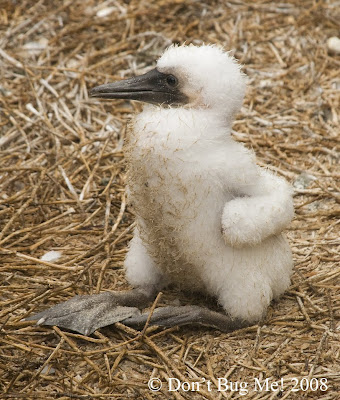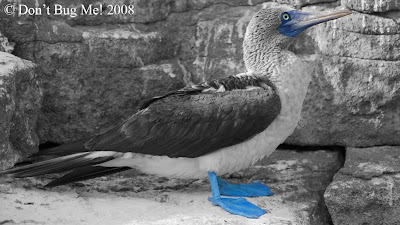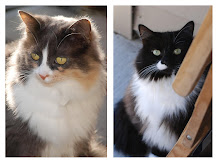- "Peek-a-Boobie" - sorry, I just couldn't resist!
 The Galapagos – rocky, volcanic islands in the middle of nowhere. Most of the islands are dry and barren, with little water and even less food. So why are they teeming with birds? Everywhere I look, there is a bird looking straight back at me. I have to watch every step I make, for fear of bumping into a booby, flattening a frigatebird or annihilating an albatross. There are eggs left all over the place and pathetic balls of fluff with gaping beaks littering the path. The poor stunted trees are festooned in feathers, the branches full of fowl. The air is no less busy a place, with more flight paths going overhead than Heathrow and Gatwick combined. The air is constantly swirling with a myriad of eddies and vortices caused by the passing wings of the wailing, screaming and screeching birds that call these islands their home. And the reason they are all here? Well, it is not like they have a whole lot of choice if they want some solid ground on which to lay their eggs and the seas around the Galapagos are rich in nutrients. These nutrients provide food for all manner of microscopic life, which in turn feed the millions of fish that inhabit the cold, equatorial waters. So, fish for all our feathered friends of these wondrous islands.
The Galapagos – rocky, volcanic islands in the middle of nowhere. Most of the islands are dry and barren, with little water and even less food. So why are they teeming with birds? Everywhere I look, there is a bird looking straight back at me. I have to watch every step I make, for fear of bumping into a booby, flattening a frigatebird or annihilating an albatross. There are eggs left all over the place and pathetic balls of fluff with gaping beaks littering the path. The poor stunted trees are festooned in feathers, the branches full of fowl. The air is no less busy a place, with more flight paths going overhead than Heathrow and Gatwick combined. The air is constantly swirling with a myriad of eddies and vortices caused by the passing wings of the wailing, screaming and screeching birds that call these islands their home. And the reason they are all here? Well, it is not like they have a whole lot of choice if they want some solid ground on which to lay their eggs and the seas around the Galapagos are rich in nutrients. These nutrients provide food for all manner of microscopic life, which in turn feed the millions of fish that inhabit the cold, equatorial waters. So, fish for all our feathered friends of these wondrous islands.

 This brings me to the main subject of this post – the booby. Go on, snigger away, I know you want to. Now that you have got that out of your system, I can enlighten you as to why they are actually called boobies. The name is apparently derived from the Spanish term bobo, meaning stupid or dunce. A little harsh perhaps, but they are quite clumsy on land and will alight on any passing ship, meaning they are easily caught by sailors – anyone for roast booby? I prefer to think that the name refers to the rather clownish antics that they perform during courtship and their delightful and endearing nature on land. Here is one particularly cheeky chap that we found on the beach one day. He is a young blue footed booby and he seemed just as interested in us as we were in him.
This brings me to the main subject of this post – the booby. Go on, snigger away, I know you want to. Now that you have got that out of your system, I can enlighten you as to why they are actually called boobies. The name is apparently derived from the Spanish term bobo, meaning stupid or dunce. A little harsh perhaps, but they are quite clumsy on land and will alight on any passing ship, meaning they are easily caught by sailors – anyone for roast booby? I prefer to think that the name refers to the rather clownish antics that they perform during courtship and their delightful and endearing nature on land. Here is one particularly cheeky chap that we found on the beach one day. He is a young blue footed booby and he seemed just as interested in us as we were in him.

 So, let’s get started by looking at a few interesting facts about boobies. Did you know that a booby is one of the fastest water diving birds in the world? They can dive from heights of over 100 ft and hit the water at a speed of 60mph (100kph). This is the reason that I don’t have any photos of diving boobies, since none of my lenses are fast enough to catch them mid dive. To prevent brain injury every time they hit the water at that speed, they have an air sac in front of the brain to cushion it and protect it from the impact. To prevent water from spurting up their nostrils and power washing the insides of their skulls clean when they dive, they have permanently closed nostrils. A fascinating feature of the nests of ground nesting boobies is the almost completely perfect circle of guano that surrounds the nest. This forms because the booby tracks the sun as it moves across the sky, keeping its back to the sun to shade the eggs from its burning rays. Since the booby will not leave its eggs, when it has to go, it stands up and shoots away from the nest, resulting in an encircling ring of excrement. Why is it that when I start looking for interesting facts about any animal, I always end up talking about poop?
So, let’s get started by looking at a few interesting facts about boobies. Did you know that a booby is one of the fastest water diving birds in the world? They can dive from heights of over 100 ft and hit the water at a speed of 60mph (100kph). This is the reason that I don’t have any photos of diving boobies, since none of my lenses are fast enough to catch them mid dive. To prevent brain injury every time they hit the water at that speed, they have an air sac in front of the brain to cushion it and protect it from the impact. To prevent water from spurting up their nostrils and power washing the insides of their skulls clean when they dive, they have permanently closed nostrils. A fascinating feature of the nests of ground nesting boobies is the almost completely perfect circle of guano that surrounds the nest. This forms because the booby tracks the sun as it moves across the sky, keeping its back to the sun to shade the eggs from its burning rays. Since the booby will not leave its eggs, when it has to go, it stands up and shoots away from the nest, resulting in an encircling ring of excrement. Why is it that when I start looking for interesting facts about any animal, I always end up talking about poop?

Now let’s have a look at the most famous of all of the boobies - the blue footed booby. It is easily recognised by its blue feet (no s#*^ Sherlock, you hardly need a PhD to work that one out, do you?!). But this does beg the question as to why these birds have feet that are so very large and so very blue. Let’s deal with the size thing first. Well, we all know that in a male big feet are a good indication of a big ................. O.K., let’s stop right there and get our minds out of the gutter, again. When a female is sizing up a male, she is interested in the size of his feet because that is what boobies use to incubate their eggs. Most birds have a brood patch, which is an area on the chest of the bird that is free of feathers and very rich in blood vessels. This allows the bird to snuggle down on the eggs to keep them warm. Boobies, despite their name, do not have this chesty feature. Instead, they use their very large feet. When a booby is incubating eggs, more blood vessels develop in their feet, which the bird then wraps around the eggs to keep them warm. Since both males and females incubate eggs, large feet are a feature that is favoured by females when she is sizing up a potential mate. As to why the feet are blue? Well, your guess is as good as mine on that one. The females obviously prefer blue feet and the male goes to great pains to show his feet off during the booby mating ritual. He will rock back and forth, lifting one foot off the ground and then the other, presenting them to his prospective mate. What appears to us to be a comical dance is apparently quite the turn on for a female booby.


Obviously not all boobies are so taken with bright blue, as we can see with the red footed booby. Now, you don’t have to be Naturalist of the Year to recognise the red footed booby. Having said that, they do have one sneaky little trick up their wings that might fool you - they come in two different colour morphs; a brown and a white form. Still, they are the only boobies that perch or nest in trees or shrubs, so life is good, life is easy. This had led me to ponder my choice of biological specialty, insects. Once in a while, I will see someone approaching me, clutching a jam jar or a margarine container and my blood will run cold. Uh oh, here we go, they have an insect or some other small creepy crawly in there that they expect me to be able to identify, since I am an expert, right? I will have a look and say something suitably intelligent like “Well, I think that it is an insect, but I have no idea what kind.” Pretty impressive, huh? You see, there are a lot of different insects out there – not just thousands or even hundreds of thousands, but millions, many of which haven’t even been described yet. So, the chances of me actually recognising one is much like the chances of me winning the lottery. I did win $1000 once, so I do get lucky sometimes, but really, I just tend to look like a bit of an idiot and people probably go away wondering where I purchased my PhD. Now, if I had decided to specialise in birds, well, that would significantly reduce the number of species that would need recognising. What about bats? They would be even better, since there are only around 1100 species worldwide. If I had specialised in bats, the chances of anyone actually bringing me one to ID would be pretty slim and even if they did I would stand a fair chance of recognising it and looking as though I actually deserve my PhD!


 Anyhoo, I really am getting a bit sidetracked here, so back to the boobies. The last of the common boobies found on the Galapagos is the masked booby. If I am going to be factually correct at this point, I should admit that these boobies are technically known as nazca boobies, but the name masked booby just conjures up a much more humorous image – just imagine what the eyeholes might line up with! The nazca boobies were particularly prevalent on Isla Española, the most southern of the Galapagos islands. As we were walking around the rocky shore, I kept hearing gentle, clacking noises and soft, breathy whistles. It really did sound as though there must be an outing of old folks with ill-fitting false teeth just behind the next boulder. I was expecting to see some old dear, sitting in a rocking chair, knitting away to her heart’s content, while her husband sat next to her, slowly nodding off with a sigh and a snort. It turns out that what I was hearing were the nazca boobies. These boobies are another ground nesting species and, like the blue footed booby, have many breeding rituals. These include clacking their beaks and raising their heads to the sky while emitting a high pitched whistle. The males will also offer “gifts” to their mates, although I am fairly sure that this female was not very impressed with the stick that this male was trying to give her. Perhaps she would have preferred it if he hadn’t kept poking her in the eye with it? While these mating rituals are very endearing, the nazca booby is not all loving and giving. After breeding, the female will lay two eggs. The first egg will hatch two days before the second and, when it is old enough, the older chick will push the younger out of the nest, leaving it to die of starvation or cold. The parent will do nothing to stop this siblicide and the younger chick is doomed to its fate even before it has hatched.
Anyhoo, I really am getting a bit sidetracked here, so back to the boobies. The last of the common boobies found on the Galapagos is the masked booby. If I am going to be factually correct at this point, I should admit that these boobies are technically known as nazca boobies, but the name masked booby just conjures up a much more humorous image – just imagine what the eyeholes might line up with! The nazca boobies were particularly prevalent on Isla Española, the most southern of the Galapagos islands. As we were walking around the rocky shore, I kept hearing gentle, clacking noises and soft, breathy whistles. It really did sound as though there must be an outing of old folks with ill-fitting false teeth just behind the next boulder. I was expecting to see some old dear, sitting in a rocking chair, knitting away to her heart’s content, while her husband sat next to her, slowly nodding off with a sigh and a snort. It turns out that what I was hearing were the nazca boobies. These boobies are another ground nesting species and, like the blue footed booby, have many breeding rituals. These include clacking their beaks and raising their heads to the sky while emitting a high pitched whistle. The males will also offer “gifts” to their mates, although I am fairly sure that this female was not very impressed with the stick that this male was trying to give her. Perhaps she would have preferred it if he hadn’t kept poking her in the eye with it? While these mating rituals are very endearing, the nazca booby is not all loving and giving. After breeding, the female will lay two eggs. The first egg will hatch two days before the second and, when it is old enough, the older chick will push the younger out of the nest, leaving it to die of starvation or cold. The parent will do nothing to stop this siblicide and the younger chick is doomed to its fate even before it has hatched.



So there you are, the boobies of the Galapagos. Now, I have never been much of a bird fan, but these boobies, especially the blue footed ones, are so charming and endearing that you can’t possibly not like them. A bit like penguins really, and we all know how much I like them, don’t we!



















